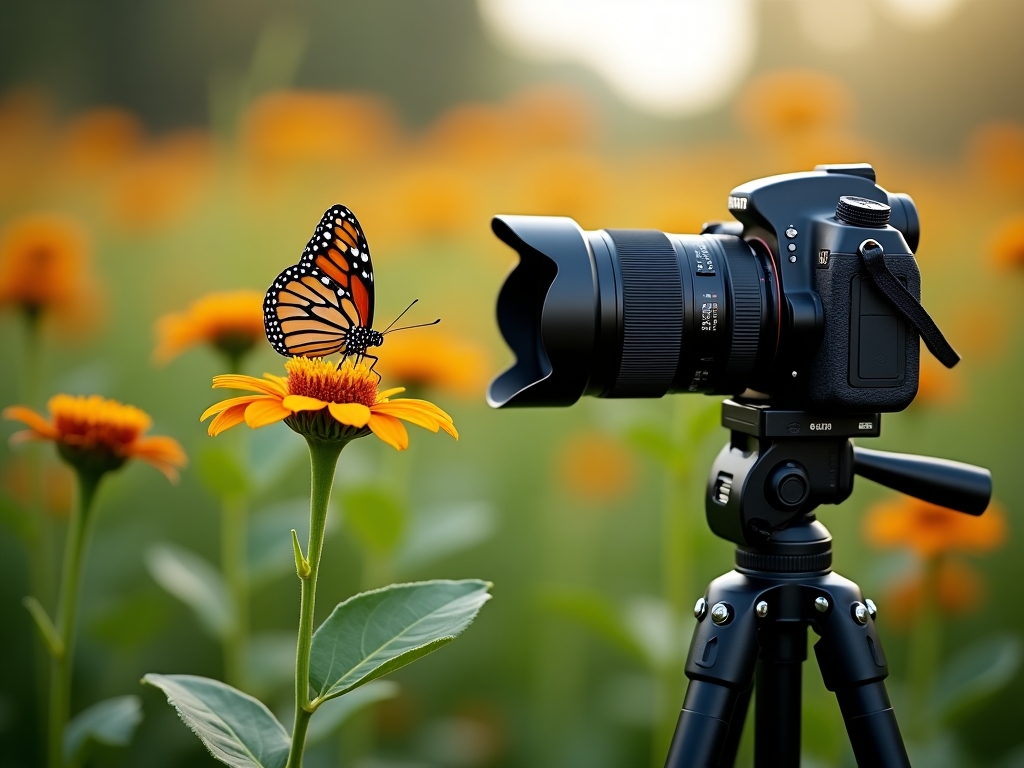Capturing the beauty of butterflies through photography presents both rewarding opportunities and unique challenges. These winged jewels combine delicate details, vibrant colors, and unpredictable movement—making them simultaneously perfect photographic subjects and technically demanding to shoot well. Whether you're a beginner with a smartphone or an experienced photographer with specialized equipment, these tips will help you create stunning butterfly images.
Equipment Considerations
While you don't need expensive gear to take beautiful butterfly photos, certain equipment characteristics will make your butterfly photography more successful:
Camera Options
A camera with interchangeable lenses offers the most flexibility, but even smartphones can capture impressive butterfly images with the right technique. If using a DSLR or mirrorless camera, look for these features:
- Fast autofocus capability for tracking moving subjects
- Good high-ISO performance for maintaining fast shutter speeds in forest shade
- Articulating screen for shooting from awkward angles without disturbing your subject
Lens Selection
The ideal lens for butterfly photography depends on your approach:
- Macro lens (90-105mm): Perfect for close-up detail shots showing wing scales and compound eyes. A true macro lens capable of 1:1 magnification lets you fill the frame with even small butterfly species.
- Telephoto lens (200-300mm): Allows you to maintain more distance from skittish butterflies. The compressed perspective can also create pleasing backgrounds.
- All-purpose zoom (70-200mm): A versatile option that works well for both environmental shots and moderate close-ups.
Helpful Accessories
Consider these additions to your kit:
- Reflector: A small, collapsible reflector can bounce light into shadowy areas, revealing wing details without harsh flash.
- Diffuser: Softens direct sunlight when photographing in bright conditions.
- Tripod or monopod: Provides stability for longer focal lengths, though the mobility limitations can be challenging with moving subjects.
- Extension tubes: A budget-friendly way to increase magnification with your existing lenses.
Technical Settings
Mastering these technical aspects will dramatically improve your butterfly images:
Shutter Speed
For perched butterflies, a minimum shutter speed of 1/250 second helps overcome minor camera shake and subject movement. For butterflies in flight, aim for 1/1000 second or faster to freeze wing motion. In low light conditions, you may need to compromise by increasing your ISO.
Aperture
Aperture selection involves balancing depth of field with light gathering:
- For entire butterfly portraits where you want the whole insect in focus, use f/8 to f/11.
- For artistic shots highlighting specific features like eyes or wing patterns, use wider apertures like f/2.8 to f/4 to create pleasing background blur.
- Remember that at macro distances, depth of field becomes extremely shallow—even at smaller apertures.
Focus Techniques
Precise focusing is critical for butterfly photography:
- Focus on the butterfly's eye whenever possible—viewers naturally look there first.
- For side views, ensure the wing closest to the camera is in focus.
- Consider focus stacking (taking multiple images at different focus points and combining them) for maximum detail when shooting with a tripod.
- For moving subjects, continuous autofocus (AF-C or Servo mode) helps track butterflies as they shift position.
Field Techniques and Approach
Your behavior in the field significantly impacts your success rate:
Timing and Weather
Plan your butterfly photography sessions strategically:
- Early morning is often ideal—butterflies are less active and may have dew on their wings, creating interesting effects.
- Slightly overcast days provide soft, diffused light that reveals wing details without harsh shadows.
- After brief rain showers can be productive as butterflies emerge to dry their wings.
- Avoid windy days when butterflies tend to shelter and plants sway, making focusing difficult.
Movement and Positioning
How you move around butterflies affects whether they stay or flee:
- Approach slowly and avoid casting shadows over your subject.
- Position yourself so your shadow doesn't fall across the butterfly.
- Move in a smooth, predictable manner rather than with sudden jerky movements.
- Consider wearing neutral colors that won't startle these visually-oriented insects.
Composition Tips
Strong composition elevates your butterfly images:
- Include environmental elements that tell a story about the butterfly's habitat.
- Watch your backgrounds—look for clean, uncluttered areas that won't distract from your subject.
- Apply the rule of thirds, positioning the butterfly's eye or body at intersection points.
- Consider the butterfly's direction—leave space in the frame for it to "look into" or "fly into."
- Experiment with different angles—shooting slightly up at a butterfly often creates more dynamic images than shooting down.
Ethical Considerations
Responsible butterfly photography prioritizes subject welfare:
- Never handle or disturb butterflies to get a shot—patience yields better results and protects your subjects.
- Avoid damaging plants while positioning yourself for photographs.
- In protected areas, stay on designated paths and follow all regulations.
- Consider contributing your images to citizen science projects like iNaturalist to help document butterfly populations and distributions.
Post-Processing for Butterfly Images
Thoughtful editing enhances your butterfly photographs:
- Subtle contrast adjustments can make wing patterns pop without looking artificial.
- Selective sharpening applied to the butterfly (but not the background) emphasizes details.
- Minor cropping can improve composition, but avoid extreme crops that reduce image quality.
- Be careful with saturation—while butterfly colors are naturally vibrant, oversaturation quickly looks unnatural.
- Consider focus stacking software for maximum detail in close-up shots.
Butterfly photography combines technical skill, field craft, patience, and artistic vision. With practice and persistence, you'll create images that not only document these remarkable insects but also convey their beauty and delicacy to viewers. Each butterfly photography session offers new challenges and learning opportunities—embrace the process and enjoy the journey of improvement.
